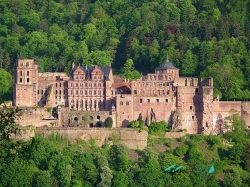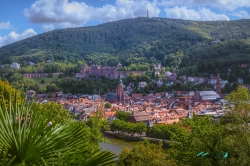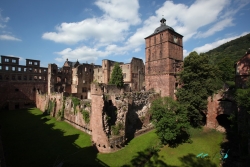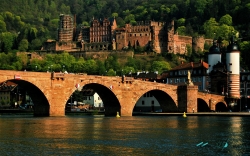Heidelberg Castle is one of the most famous ruins in Germany and the symbol of the city of Heidelberg. Until it was destroyed in the War of the Palatinate Succession, it was the residence of the Electors of the Palatinate. Since the destruction by the soldiers of Louis XIV in 1689 and the demolition by French pioneers on September 6, 1693, the Heidelberg Castle has only been partially restored. After lightning had set the partially renovated facility on fire on June 24, 1764, the restoration was abandoned. The castle ruins made of red Neckar valley sandstone rises 80 meters above the valley floor on the northern slope of the Königstuhl and from there dominates the image of the old town. The Ottheinrichsbau, one of the palace buildings of the castle, is one of the most important structures of German Mannerism. In the cultural-historical epoch of Romanticism, the castle ruins were stylized as the epitome of a bygone and admirable epoch. Today it is one of the most visited tourist attractions in Europe.
Around 1182, Konrad der Staufer, half-brother of Emperor Friedrich I Barbarossa and since 1156 Count Palatine of the Rhine, moved his court from Stahleck Castle near Bacharach on the Middle Rhine to Heidelberg Castle , his seat as Vogt of the Schönau monastery in the Odenwald .
The city of Heidelberg is mentioned for the first time in a document in 1196. A castle in Heidelberg ("castrum in Heidelberg cum burgo ipsius castri") is mentioned in 1225, when Ludwig I received this castle from Bishop Heinrich von Worms as a fief. In 1214 the dukes of Bavaria from the House of Wittelsbach were enfeoffed with the Palatinate.
A castle was last mentioned in 1294. In a document from 1303, two castles are listed for the first time: the upper castle on the Kleiner Gaisberg near the current Molkenkur and the lower castle on the Jettenbühl. For a long time, researchers believed that the foundation of the lower castle must have been built between 1294 and 1303, especially since the building survey meticulously carried out by the castle construction office in the second half of the 19th century concluded that the structure of the building had no dating of the castle before the 15th century. On the basis of architectural discoveries and recent building archaeological investigations, however, the development of the lower castle is now dated to the first half of the 13th century in recent research on Heidelberg Castle. As early as 1897, a bricked up late Romanesque window was discovered in the partition between the Gläsernem Saalbau and Friedrichsbau. In 1976, excavation work on the northeast corner of the Ruprecht building uncovered a window fragment in the form of a clover leaf arch in a layer of rubble and rubble deposited around 1400, as can be found in a similar form in the arcade windows of Wildenberg Castle. An archaeological investigation carried out in 1999 in the area of the Ludwigsbau condensed the evidence of a development of the palace area in the first half of the 13th century.
Around 1182, Konrad der Staufer, half-brother of Emperor Friedrich I Barbarossa and since 1156 Count Palatine of the Rhine, moved his court from Stahleck Castle near Bacharach on the Middle Rhine to Heidelberg Castle , his seat as Vogt of the Schönau monastery in the Odenwald .
The city of Heidelberg is mentioned for the first time in a document in 1196. A castle in Heidelberg ("castrum in Heidelberg cum burgo ipsius castri") is mentioned in 1225, when Ludwig I received this castle from Bishop Heinrich von Worms as a fief. In 1214 the dukes of Bavaria from the House of Wittelsbach were enfeoffed with the Palatinate.
A castle was last mentioned in 1294. In a document from 1303, two castles are listed for the first time: the upper castle on the Kleiner Gaisberg near the current Molkenkur and the lower castle on the Jettenbühl. For a long time, researchers believed that the foundation of the lower castle must have been built between 1294 and 1303, especially since the building survey meticulously carried out by the castle construction office in the second half of the 19th century concluded that the structure of the building had no dating of the castle before the 15th century. On the basis of architectural discoveries and recent building archaeological investigations, however, the development of the lower castle is now dated to the first half of the 13th century in recent research on Heidelberg Castle. As early as 1897, a bricked up late Romanesque window was discovered in the partition between the Gläsernem Saalbau and Friedrichsbau. In 1976, excavation work on the northeast corner of the Ruprecht building uncovered a window fragment in the form of a clover leaf arch in a layer of rubble and rubble deposited around 1400, as can be found in a similar form in the arcade windows of Wildenberg Castle. An archaeological investigation carried out in 1999 in the area of the Ludwigsbau condensed the evidence of a development of the palace area in the first half of the 13th century.






